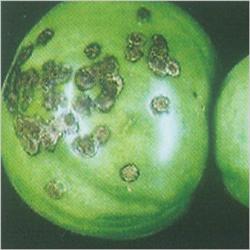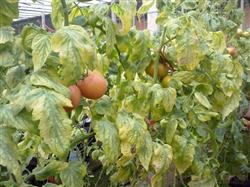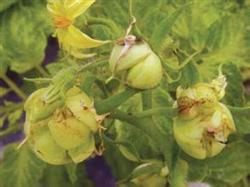Symptoms and Chemical Control of Tomato scab

★ symptoms: tomato leaves, stems and fruits can be infected with scab. The old leaves near the ground fell ill first, and the primary water-flooded dark green spots were enlarged to form brown spots with near-round or irregular edges, with a yellow ring and narrow halo ring around it, with thin interior and greasy luster. The stem infected man is flooded in dark green to yellowish brown irregular disease spot, the disease part is slightly raised, and it is scab-like after cracking. The fruit infection is mainly caused by the young fruit and green fruit before coloring, the primary round is surrounded by narrow white spots, and the middle depression shows dark brown or dark brown raised ring spots, which is an important feature of the disease. The pathogen of ★: Xanthomonas campestris pv.vesicatoria (Doidge) Dye (Xanthomonas vesicatoria (Doidge) Dowson), which is called Xanthomonas campestris sore spot pathogenic type, or pathogenic variety of horseradish scab, and belongs to bacteria. The cell is short rod-shaped, obtusely round at both ends, 1.0-1.5 × 0.6-0.7 μ m in size, with a flagellum at the end, gram-negative staining, suitable temperature for development of 27 ℃ 30 ℃, maximum 40 ℃, minimum 5 ℃, 56 ℃ died in 10 minutes. In addition to infecting tomatoes, it also harms sweet (spicy) peppers. The transmission route and pathogenic condition of ★: the pathogenic bacteria overwintered on the surface or attached to the seed surface with the disease residue. In the next spring, the bacteria spread to tomato leaves, stems or fruits through wind, rain or insects, invaded from the wound or stomata and propagated between cells. at the same time, the injured cells were decomposed and the pathogenic part was sunken. The incubation period of infected leaves was 3ml for 6 days. Infect the fruit for 6 days. High temperature, high humidity, overcast and rainy weather are important conditions for the disease, borer pests and storms cause wounds, extensive management, plant weakness and serious disease. ★ prevention and treatment methods: (1) use disease-free seeds, or disinfect diseased seeds. The seeds were soaked in 55 ℃ warm water for 10 minutes and cooled in cold water to accelerate germination. (2) the seriously diseased fields should be rotated for 2-3 years. (3) strengthening management, timely regulation and timely pest control. (4) at the initial stage of the disease, 47% Jiarinong wettable powder 600x solution or 50% copper succinate (DT) wettable powder 400ml 500x solution, or 77% wettable particulate powder 400ml 500x solution, 25% ammonia copper solution 500x solution, streptomycin sulfate or neophytomycin 4000 times solution, once every 710 days, were sprayed once or twice.
- Prev

How is the yellow leaf of tomato and roll leaf disease to return a responsibility? How to prevent and cure?
Consultation content: how is the yellow leaf of tomato and leaf roll disease to return a responsibility? How to prevent and cure? Answer content: Hello! Tomato yellow leaf and leaf roll disease: if the disease is accompanied by Bemisia Tabaci (small white moth), it is likely to be tomato yellow mosaic leaf curl virus disease (commonly known as TY virus disease). TY virus.
- Next

How does the tomato appear abnormal fruit to return a responsibility?
Consultation content: how is the malformed fruit of tomato going on? Is it because Baoguoning is not used well? Answer content: Hello! There is a certain relationship between the abnormal fruit of tomato and the improper use of auxin. For example, the concentration used is too high. Dipping time has reached noon, the temperature in the shed is too high, can form deformed fruit.
Related
- Where is it suitable to grow horseradish in China? it is expected to see the middle altitude horseradish in Alishan.
- How to prevent tomato virus disease reasonably? (Control methods included)
- Many people like to plant towel gourd on the balcony. What are the main points of this method and management?
- What crops can chili peppers be mixed with?
- Fertilization techniques and matters needing attention in Tomato
- What are the grafting techniques for peach seedlings in spring?
- Harm and control methods of root swelling disease of Chinese cabbage
- What are the pests of sweet potatoes? How to prevent and cure it?
- Symptoms, causes and Control methods of navel Rot in Tomato
- The cause of "Cucumber rotten bibcock" in Farmers' planting Cucumber and its Control Plan

